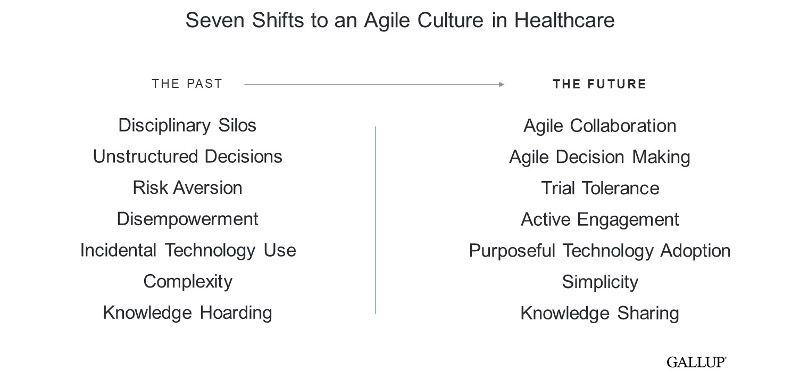Article
Contributor: Seven Shifts to an Agile Culture in Health Care
Author(s):
Agility has long been a big buzzword, but its salience and importance has been growing. Gallup’s research on agility finds that there are 7 fundamental shifts common to highly agile leaders—driving these changes through a hospital can help significantly advance a culture of agility.
Agility has long been a big buzzword, but its salience and importance has been growing.
A study by McKinsey found that 9 out of 10 executives said organizational agility was critical to business success and growing in importance over time. But according to Gallup's research before the pandemic, only 18% of employees felt that their companies were genuinely agile.
Customers may not see the disconnect between leadership priorities and ground-level realities, but they can feel the effects–especially health care customers. Gallup research in 2020 shows that 6 in 10 Americans believe the US health care system is in a state of crisis (16%) or has significant problems (45%), the worst results Gallup has found since 1994 (except once in 2001).
The pandemic laid the problem bare. Health care providers worldwide struggled to acquire personal protective equipment, critical ventilators and beds, and according to Gallup surveys in the height of the pandemic, a little less than 1 in 2 health care workers felt that they had enough communication and a clear plan of action for COVID-19. The record on agility in health care has been dismal at a time when agility was needed the most.
But in the end, patient satisfaction is the final arbiter of a medical institution. And most patients (8 in 10) are not very satisfied with the quality of medical care in the United States in 2020. After a year like that, this might be expected. But that number hasn’t changed since 2000.
Agility Imperatives
The ability to respond quickly to the customer and the environment is why leaders believe agility is essential. But in a hospital, agility isn’t just about being faster and more patient-centric; it’s also about finding new ways of working more purposefully. Gallup believes that in health care, purposeful agility includes 3 key elements:
- Adaptability, so hospitals can do more with less, navigate disruption, and collaborate cross-functionally and with external partners to keep health care staff engaged, inspired and productive.
- Speed, which generates prompt responses and promotes flexibility. That’s increasingly important as alternatives emerge to the traditional health care hospital setup.
- Execution, because focusing on getting things done removes friction and improves outcomes. That has weighty implications for value-based care in the post-COVID world.
The COVID-19 vaccines are an excellent example of agility in health care. Typically, it takes 10-15 years before a vaccine meets all FDA protocols, but the Pfizer and BioNTech vaccines were authorized just 8 months after trials. Many others vaccines followed agile development, trials and approval without cutting corners on safety and efficacy. In the US, development and trials were expedited through the efforts of the government and distributed at a rapid rate under the aegis of Operation Warp Speed. Vaccine development and deployment also required extensive global cooperation, strategic planning and the collective talents of clinical and non-clinical employees, partners, vendors, and distributors across the world.
Evidence of the presence of the agility mindset should reassure health care leaders that their people have the mindset that enables fast decision-making, experimentation, and learning. But evidence of the agility mindset doesn’t make a hospital culture agile. To that end, health care providers ought to ask themselves these 2 questions to understand their organizations’ capacity for agility:
- Do we have the right tools and processes to respond quickly to business needs?
- Do we have the right mindset to respond quickly to business needs?
If the answers are yes, the organization is in an advantageous position: Gallup research shows that those who feel that they have the agility mindset and the right processes for agility are 3 times more like to be confident in the financial future of their organizations and a whopping 5 times more likely to feel their organization is ahead of their competition.
If the answers are no, shifting into an agile-ready culture may be required.
Seven Shifts to an Agile Culture
Gallup’s research on agility finds that there are 7 fundamental shifts common to highly agile leaders. Driving these changes through a hospital can help significantly advance a culture of agility.

From Disciplinary Silos to Agile Collaboration
Hospitals moved to team-based patient care some time ago as a logical response to the many clinical, nonclinical and technical staff touch points patients require. That level of collaboration is necessary for critical clinical outcomes and to avoid medical errors–which cause 250,000 deaths a year, according to some estimates–yet hospitals themselves may not reflect that collaborative behavior.
Leaders must intentionally focus their teams on the agile behaviors that can topple barriers and encourage broad-based collaboration through cross-functional project and sprints aimed at specific quality or clinical outcomes. Agile collaboration must be at a broader level of the ecosystem—critically between clinicians and administrators and amongst providers, payers, manufacturers, and regulators.
From Unstructured to Agile Decision-Making
Health care is unpredictable, which makes objective decisions hard to reach. Nonetheless, timely, quality decisions are crucial to success for health care providers, and unfocused, unstructured decision making is a barrier to agile working. As health policies and practices change, decisions based on old data and legacy systems will prove increasingly ineffective.
Applying agility to decision making will require gaining inputs across the spectrum of health care workers—clinicians, engineers, managers, data scientists, and, importantly, frontline staff—to reach informed, objective decisions. Patients, too, must be included through a shared decision making (SDM) model, in which patients exercise the right to choose their treatment.
From Risk Aversion to Trial Tolerance
By its nature, health care is risk-averse. The practice requires precision and clarity, and its sole purpose is to reduce patients’ risk of ill health. But disruptions like the pandemic emphasize the need for greater risk tolerance.
Hospital leaders must educate their teams on prudent risk-taking through education, risk simulation training, and coaching. Importantly they must engage their team's assessment and dialogue around risk, market trends, and potential disruptions in the health care model at the local and global levels.
From Disempowerment to Active Engagement
Many health care organizations are structured on a traditional command-and-control model. This creates order, structure, and consistency, but it is ill-suited for the kind of rapid development and strategy pivots required in the modern, post-pandemic health care reality.
Gallup's research shows that managers are crucial to engagement and empowerment—70% of the variance in team engagement is due to the managers—but health care managers are not always trained to engage, inspire, and support health care staff. Development is necessary for any manager, but more so in teams that need to drive greater empowerment, speed, agility, and performance.
Health care leaders must get adept at involving and engaging their teams through purposeful rounding, eliminating barriers to clinical care, and gaining a deeper understanding of individual engagement needs.
Managers who develop the power of engagement and the purpose of agility are enormous assets in a changing environment. In the health care environment, in which laborious command-and-control systems are increasingly ineffective, such managers are crucial.
From Incidental to Purposeful Technology Adoption
Technology is transforming health care. According to Gallup analytics, the use of telehealth alone will explode, and hospitals are becoming more and more interested in tech that drives value for patients.
But not all health care technology is as effective as it should be. Perhaps the poster child of disappointing technology is the electronic health record (EHR). It’s estimated that 30%-50% of EHR implementation efforts fail. So, solving a health care process problem is not as easy as throwing technology at it. Post-pandemic, there is a greater need for health care providers to use technology purposefully to shift from traditional ways of working to a more user-centered design of new tech.
This will require a high degree of technology readiness from health care administrators, executives, and technologists and an orientation toward the purposeful utilization of technology to directly impact the patient, clinician, and hospital staff experience.
Testing, validation, and technology adoption should also include user feedback through prototyping or the use of micro-test sites that simulate the patient experience and perfect user interface and user experience delivery before going to market.
From Complexity to Simplicity
Much of the talk about business agility centers on the speed with which employees can take action to solve problems. Speed requires employee empowerment, decentralized decision-making, and a focus on procedural simplicity. But recent Gallup research has shown that only 13% of US employees feel that they always look for the simplest way to get the job done in their company.
That’s worrisome. Agility is not about setting up new structures, task forces, and processes. Agility is about simplicity. Simplifying may mean replacing unproductive and highly complex, and bureaucratic systems that impede performance and productivity. It may also mean undercutting organizational rigidity and bureaucracy.
Centering simplification efforts around the patients and involving team members across clinical and non-clinical functions is vital. Cross-functional team huddles help, as do problem-solving or clinical quality projects that map the patient journey across the broad spectrum of patient experiences.
From Knowledge Hoarding to Knowledge Sharing
Health care organizations today are data-rich. Data can save lives, making effective and efficient use and sharing of data, knowledge, and information even more critical
A Healthcare Information and Management Systems Society (HIMSS) 2020 Health IT Conference poll reported that one of their top digital innovation goals centered on modern collaboration, in addition to enhanced security, interoperable data, and patient satisfaction. Meanwhile, agile health care organizations must center their data and knowledge sharing on what driving value for end-customers and patients.
Therefore, an agile hospital needs a knowledge management system with a heavy external customer orientation rather than an internal process orientation–and all that information and knowledge must be widely shared.
Here, a key element is integrating data sets and knowledge across all patient interactions and episodes into one single patient view. That single view will enhance effectiveness, reduce risks, and significantly enhance data privacy, PHI, and HIPAA compliance.
The Path to Health Care Agility
These 7 fundamental shifts to an agile culture are vital and require broad-based adoption to be successful. Agility, after all, is the ability to adapt to market dynamics nimbly and respond to health care needs rapidly. This means that organizational agility is not the same thing as "agile methods." The core elements of truly agile culture are adaptability, speed, and execution–and those aren’t methods. They’re means.
To be truly agile, health care leaders must try harder to invest in developing capable managers who are focused on engagement. To be better, they must fuel their organizations by investing in talent—the talent with the right mindset is empowered with tools, systems, and processes to drive change. And they need an organizational culture that values flexibility, innovation, and agile risk-taking.





